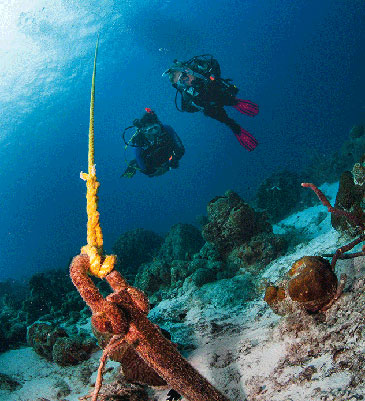Lesson 45
You will learn how to manage your air and avoid the risk of running out of air
1. How do my buddy(ies) and I manage our air supply together while diving?

You manage your air supply while diving, but you interact with your buddies as you do so. This is important because people use air at different rates. Someone will always use air the fastest, and someone the slowest. Throughout the dive, you and your buddy(ies) share air supply information, then turn the dive and head back based on the diver who’s using it the fastest.
On many shallow dives, where air supply is the usual limiting factor (you’ll learn some other factors in Section Four), you can plan your air use something like this (Note: Metric and imperial figures are not equivalent; the example uses pressures commonly used by divers in the respective systems.):
- You and your buddies are diving from a boat and have the same size cylinders. You all start the dive with 200 bar/3000 psi.
- You agree that 50 bar/500 psi is ample reserve pressure – the minimum you want to have left at the end of the dive.
- Now plan for the air you’ll use during your ascent and safety stop. Based on the depth, you agree that you want to save 20 bar/300 psi for this. Put this with your reserve so you know the pressure at which you should be heading up – in this case, 70 bar/800 psi (50 bar + 20 bar = 70 bar/500 psi + 300 psi = 800 psi).
- Take this from your starting pressure, and what’s left is the pressure you can use for the main part of the dive. In this case, you have 130 bar/2200 psi (200 bar – 70 bar = 130 bar/3000 psi – 800 psi = 2200 psi).
- To simplify, you agree to use half of this swimming out, then turn the dive and use the other half for the return. This means you’ll turn around when one of you has used 65 bar/1100 psi. (Half of 130 bar is 65 bar; half of 2200 psi is 1100 psi.)
- Take this pressure away from your starting pressure to find the pressure at which you head back. You’ll turn the dive when either you or your buddy’s SPG reads 135 bar/1900 psi. (200 bar – 65 = 135 bar, or 3000 psi – 1100 psi = 1900 psi.) This is called your turn pressure – the SPG pressure at which you turn around.
- Note your starting air pressure, planned reserve and planned turn pressure on the PADI Skill Practice and Dive Planning Slate for reference during the dive.
Turning the dive at 135 bar/1900 psi leaves 65 bar/1100 psi for swimming back. When you get there, you should have at least 70 bar/800 psi for your ascent, safety stop and reserve. After you surface, you should have at least 50 bar/500 psi – your reserve – remaining

Do not risk running out of air underwater. Sometimes buddies use different sized cylinders or start with different pressures. To conservatively adjust for slight differences in cylinder sizes and starting pressures, plan your air management based on the smallest air supply.
In reality, with appropriate conservative dive planning and habits, you will often use a bit less air than planned coming back. In many circumstances, you can adjust and delay your ascent to enjoy your “extra” air. For example, suppose you and your buddy reach the mooring line with 100 bar/1100 psi remaining. You can explore the immediate area around the mooring until you have to head up at 70 bar/800 psi.
Quick quiz
Module Two

I'll take you diving!
Copyright © Larry Wedgewood Scuba Instruction All Rights Reserved

